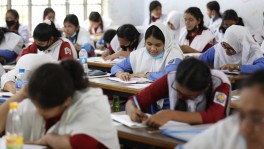Nine to six: Dawn to dusk!
Inflation is not arising out of economic forces, rather it seems to be emerging from non-economic artificial forces

The nomenclature of economics stipulates that the respective wing of the government administers a country's fiscal policy.
And the central bank remains in charge of monetary policy.
It has been recently witnessed that vested interest groups are rolling out monetary policies instead of the authority that is tasked to do so.
But this is the most important tool to control the money supply and inflation in the economy.
Surrendering to the pressure of businessmen, the government put a gun to the central bank's head. The intention seems inevitable!
Recently, the central bank took a timely decision amid the ongoing Covid-19 outbreak to cut down the regulatory cash reserve requirement by 50 basis point and the policy rate by 25 basis point.
To combat the upcoming recession, that may unavoidably hit our economy, there were no other options except for this monetary policy tool.
The Reserve Bank of India has also taken a series of steps including slashing cash reserve ratio by 100 basis point and policy rate by 75 basis point.
The Bangladesh Bank has not yet taken any decision to revisit the minimum threshold level of capital adequacy ratio or any of its major component.
Recently, the Reserve Bank of India and the State Bank of Pakistan opted for regulatory relief to cushion the effects of the Covid-19 outbreak.
Both central banks have given the banks a relaxation for maintaining capital conservation buffer (CCB), a Basel III regulatory capital ratio, in addition to the minimum capital.
However, nine to six or vice versa refers to the implementation of the single-digit interest rate. This decision has seemingly been taken by the finance ministry, only to satisfy the vested interest groups, at the expense of the country's economy.
In a country, where the inflation rate hovers around six to seven percent, such decision to fix the interest rate on deposits at six percent would ultimately leave the depositors with zero or even negative real interest rate.
It is evident that, to bring down the lending rate to a single digit, there is no other option but to put a ceiling on the deposit rate as well. This was the science behind putting the maximum cap on the deposit rate at six percent to keep a spread of three percent.
The interest rates in the economy should be aligned with each other. It is quite surprising to have six percent deposit rate offered at banks, whereas, national savings certificates (NSCs) are carrying more than 10 percent interest rates.
It is already evident that the government had tried to refix the NSCs by cutting the rate, following the rate offered by the banks. However, the government had to step back within the shortest time from implementing this.
The government has been incurring huge expenses through interest pay-out arising from the NSCs and this is a burden on its shoulder.
Experts maintain that the government should cut its borrowing from selling NSCs which is a highly expensive instrument compared to other sources including debt instruments.
Instead of focusing only on bank interest rates, it will be much more reflective to focus on other tools.
Firstly, the exchange rate has been kept high only to promote export, whereas, the country is in a net importing position.
This high exchange rate is attributable to an inflation spiral which reduces the growth of aggregate demand to combat the inflationary pressure.
A higher interest rate, which also leads to a higher exchange rate, is supposedly helping cut inflationary pressure. But practically, this higher exchange rate makes imported goods more expensive which directly have an impact on the general price level.
This country is in the middle-income category where the majority of the population belongs to the middle to lower-middle class.
The lower-income savers should be incentivised in such a way that they may end up with a considerable real return in their old age.
A huge number of potential taxpayers still could not be brought under the tax net which could be the biggest source for the government to carry out development expenditure – needless to say, the cheapest too.
The supply-side dynamics of necessary consumer goods is not working properly, as the middlemen, formally known as syndicates, are reaping the benefit by depriving the marginal producers.
In a true sense, inflation is not arising out of economic forces, rather it seems to be emerging from non-economic artificial forces.
For the last few years, the banking sector has been experiencing a debacle. The non-performing loans (NPLs) have brought big troubles for the banks.
The swindling by the owners has seriously dampened the reputation of the overall banking sector.
It is quite unbelievable that one person swindled such a large sum of money from two non-bank financial institutions.
The 60 plus banks in such a small country are prone to high NPL ratio, fierce competition in mobilising deposits, balance sheet window dressing, and so on.
So before going for the implementation of six-nine percent interest rate regime, the policymakers should focus on the aforementioned important tools to manage the economic indicators.
Once these get fine-tuned, they will expectedly be able to implement the desired single digit interest rate in the banking sector.
Otherwise, there is a possibility that this decision could take the banking industry from dawn to dusk – with the sky growing dark in distance.
The writer is risk manager of a foreign bank in Bangladesh


 Keep updated, follow The Business Standard's Google news channel
Keep updated, follow The Business Standard's Google news channel
















